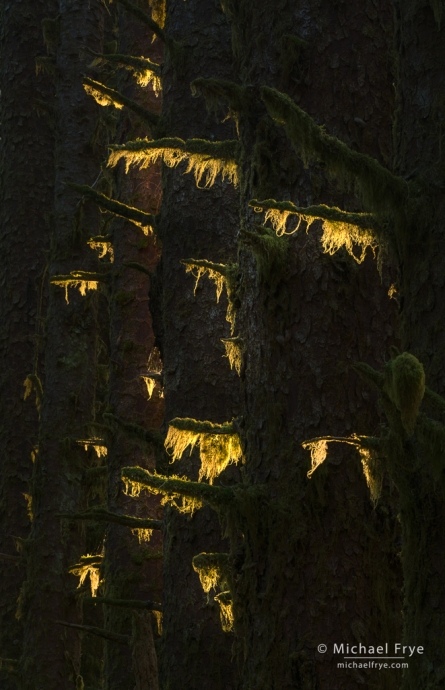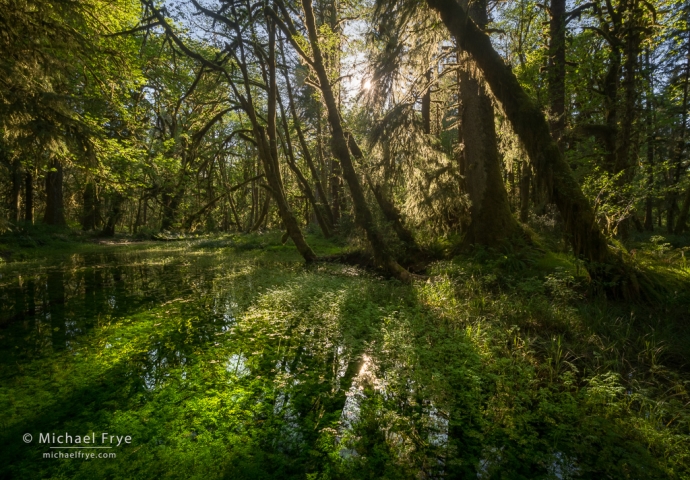After our Death Valley workshop, wildflower odysseys, and quick trip to Tucson for the NANPA Summit, Claudia and I flew up to Seattle and drove to the Olympic Peninsula for the Out of Olympic photography conference.
That was such a fun event, with a great group of participants, and wonderful instructors. It was great to meet or reconnect with so many good people. And, as usual, the conference was really well organized by Chris Smith and his Out of Chicago team.
For the conference field sessions I was paired with fellow instructor Colleen Miniuk (aka “Bubbles”). If you know Colleen you know she’s an exuberant personality, and a joy to be around – as well as a great photographer and instructor. We had a lot of fun together.
And the locations were beautiful. I hadn’t been to the Olympic Peninsula for a long time, and it was so nice to go back. The coastal beaches and sea stacks in that area are amazing, but I was especially taken with the forests. I love temperate rainforests, like the ones in the northern California redwoods, or New Zealand. But what stands out to me in the Olympic forests is all the hanging moss (it’s really lichen, but everyone calls it moss). You find some of that in the redwoods or New Zealand, but it’s especially abundant and luxurious on the Olympic Peninsula.
That hanging moss or lichen is quite photogenic – in the right situation. We had lots of sunshine before, during, and after the conference, which is rather unusual for that part of the world. I typically prefer soft light for forest scenes, but that sunlight often worked really well for the hanging lichen – especially when it was backlit, shining through the long tendrils.
Of course forest scenes are often quite complicated and messy, making them hard to photograph. I’m always looking to simplify these kinds of scenes – to pare the image down to its essentials.
But in addition, I think nearly every photograph needs to have a visual focal point – something that stands out from its surroundings that the viewer’s eye can latch onto. And most images benefit from having lines or shapes that echo each other – in other words, repeating patterns. Or if not a pattern, some other design element, like a curve, circle, triangle, diamond, or fan shape.
And while designs, patterns, and focal points are important components of most successful compositions, I think they’re especially essential with complex scenes like forests. A focal point gives viewer’s something to latch onto before their eyes roam around all that complexity. And patterns or other design elements give the image structure, helping to organize the chaos, and make the photograph easier to comprehend and digest.
So here’s a collection of images from our time on the Olympic Peninsula. As you look through these photographs, see if you can a find pattern, design element, or focal point in each image. Some of these compositions are more about patterns, but there’s usually some kind of focal point as well, though it might be subtle. If in doubt, notice where your eyes go first, or return to most often. Some patterns and designs might be obvious, but others could be rather subtle as well. (In forests, one thing to look for is repeating vertical lines of tree trunks.) And keep in mind that a photograph can have primary, secondary, and tertiary focal points – not just one. And it can have more than one pattern as well.
Claudia and I had so much fun exploring and photographing this area. Luckily we won’t have to wait long to go back, as I’ll be co-leading a workshop with Jerry Dodrill there this October for Visionary Wild. (As I post this there’s one spot available, but if that spot fills I encourage you to get on the waiting list if you’re interested in this or any other workshop.) Can’t wait!
— Michael Frye

Sun setting through a natural bridge, Olympic NP, Washington. During the conference our group had fun photographing the sun setting through this natural bridge along the coast.
Related Posts: Wildflower Odysseys; Simplifying Forest Scenes
Michael Frye is a professional photographer specializing in landscapes and nature. He is the author or principal photographer of The Photographer’s Guide to Yosemite, Yosemite Meditations, Yosemite Meditations for Women, Yosemite Meditations for Adventurers, and Digital Landscape Photography: In the Footsteps of Ansel Adams and the Great Masters. He has also written three eBooks: Light & Land: Landscapes in the Digital Darkroom, Exposure for Outdoor Photography, and Landscapes in Lightroom: The Essential Step-by-Step Guide. Michael has written numerous magazine articles on the art and technique of photography, and his images have been published in over thirty countries around the world. Michael has lived either in or near Yosemite National Park since 1983, currently residing just outside the park in Mariposa, California.

















The Olympic beaches and forests have been my stomping grounds ever since the early 70’s. Amazing place and you captured some great images. The river shot has beautiful lighting and of course Second Beach at sunset is always a great place to be no matter what the weather.
Thanks Aram. It’s a wonderful area, and I’m glad you’ve been able to spend so much time there.
Please add me to your mailing. And thanks for a great session at Salmon Cascades and Ancient Groves.
Lisa
We added you to the list Lisa. Glad you enjoyed the session at Olympic – that was fun! As I recall, that was one of the more memorable segments from Colleen’s video… 🙂
The river scenic is grand and noble!
Thanks very much Felix!